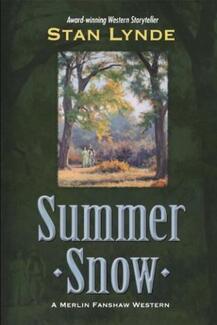Stan Lynde was born and reared on the rangelands of the Crow Indian Reservation of southeastern Montana. He is the creator, author, and artist of two highly acclaimed nationally syndicated cartoon strips, Rick O’Shay and Latigo.
Stan has been listed in Who’s Who in America and Who’s Who in American Art. He received the Inkpot Award in 1977 for achievement in the comic arts and the Montana Governor’s Award for the Arts in 1983. Stan is a prolific and popular author of western fiction. His eight published novels, set in Montana Territory during the 1880s, include seven novels in his Merlin Fanshaw series.
He is a 2009 winner of Western Writers of America’s prestigious SPUR Award for the audiobook of his 2008 novel, Vendetta Canyon. Stan and his wife Lynda live in Helena, Montana.
* * * * *
I became a storyteller in the usual way--by listening to and reading stories, in particular stories of the history, lore, and legend of the American West. Growing up on the big open ranges of the Crow Indian Reservation in southeastern Montana, my heroes were cowboys of the old school. I loved everything about them. As a kid, I followed my bow-legged role models around, got in their way, pestered them with questions, and disobeyed my mother's strict orders not to hang out at the bunkhouse.
As for the cowpunchers themselves, they were surprisingly tolerant, pretending they didn't notice the big-eyed kid curled up in the corner and taking in the tales they told--tough, funny, sad, true, and tall.
I learned to sit a horse and work sheep and cattle, but I never became a decent roper and I was never what you'd call a top hand. I attended school in the small reservation town of Lodge Grass, working summers on my dad's ranch, and the bunkhouse and bedroll became my homes away from home. I bothered the cowboys and ranch hands less, but I still took in their stories, and I began to make up my own.
Louis L'Amour wrote, "I think of myself in the oral tradition--as a troubador, a village tale teller, the man in the shadows of the campfire. That's the way I'd like to be remembered--as a storyteller. A good storyteller." Louis's goal became my own.
In 1958 I created the comic strip Rick O'Shay, and for the next nearly twenty years wrote and drew the adventures of Rick, Hipshot, Gaye Abandon, and all the many characters who played out their stories in and around the town of Conniption. The strip ran in nearly 100 newspapers across America and abroad, and was read by an estimated 15 million people daily. I left the strip in 1977 and went on to syndicate a second western strip, Latigo, which ran from 1979 to 1983 in nearly the same number of newspapers. Other strips followed--Sly Fox and Rovar Bob for Fantomen Magazine in Sweden, and a panel cartoon, Grass Roots, for weekly papers in the western states.
Then, in 1989, I married Lynda Brown and told my stories to her. Lynda must have been impressed. She read one of my stories and instantly brought the same total commitment to my career as she has to our marriage. She encouraged me to write western fiction, we formed our own publishing company, and I tackled my first novel.
That first effort turned out to be a coming-of-age story of a boy's struggle to deal with his father's murder and become a man, and to my surprise the book turned out to be a struggle as well. I'd been writing westerns all my life, drawing on remembered bunkhouse palaver, research, and my own experience; why, I wondered, was this story so difficult?
The answer, of course, is that a novel is different from a comic strip or screen play. I would have to put in some time and effort to learn the new form. I was not really such an old dog, but I would have to learn some new tricks.
I was blessed to have a gifted writer as a friend and advocate. Author of the best-sellers Blood Red Wine and The Triton Ultimatum, Larry Delaney became my drill sergeant and mentor. Larry taught me how to give life to my writing and encouraged me to raise my standards. He helped me to become a novelist.
I continued to struggle with my coming-of-age story, and finally gave up and put it aside. I took a break. I went back and re-read some of the western authors I most admired--Dorothy M. Johnson, Ernest Haycox, Luke Short, Will Henry--and one day I heard a new voice inside my mind. The voice, it turned out, belonged to a young cowboy with a story to tell. The cowboy was Merlin Fanshaw, and his story became my first novel, The Bodacious Kid.
Since that time, seven more books featuring Merlin's adventures have been published, and the Kid has grown older and wiser with each one. I've been asked which of the seven books is my own favorite. I usually say, "The next one."
Books in the Merlin Fanshaw series have developed quite a following. They've gone on to win recognition and acclaim, including the prestigious Western Writers of America SPUR Award. But it was The Bodacious Kid that started it all, and for that reason alone it will probably always be my favorite. It's my first-born, after all.
If the Merlin Fanshaw westerns are new to you, I urge you to make their acquaintance. Take a ride with Merlin--I think you'll enjoy the trip!
Happy Trails,
Stan Lynde




